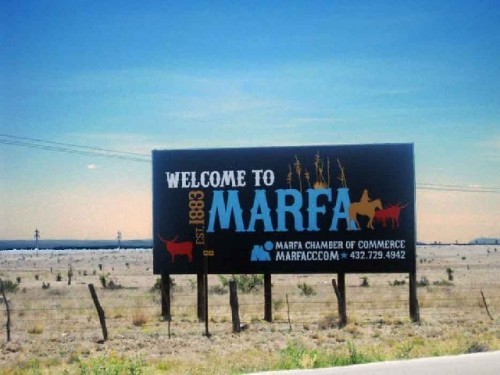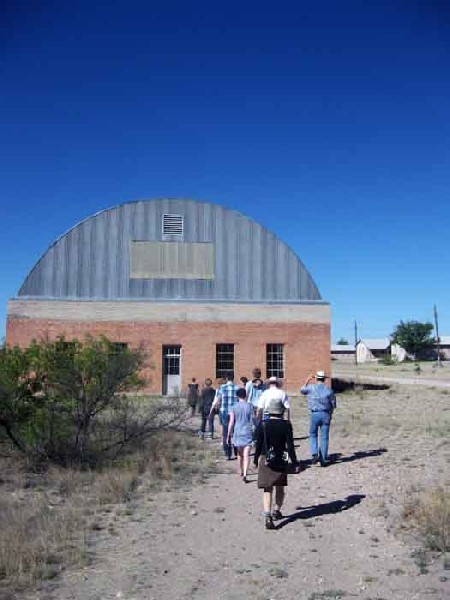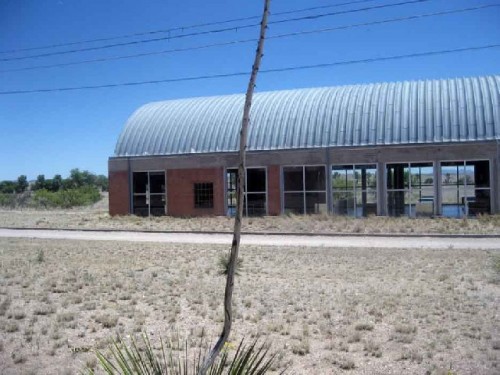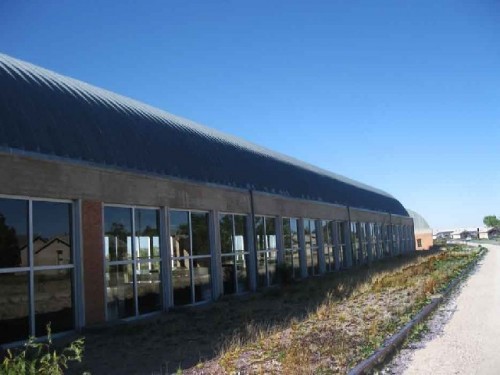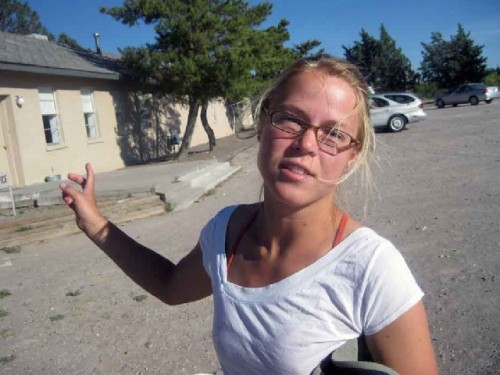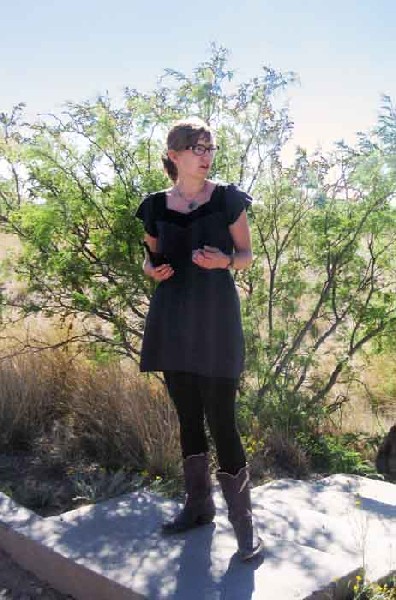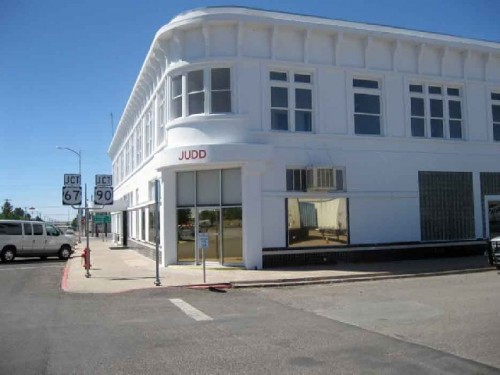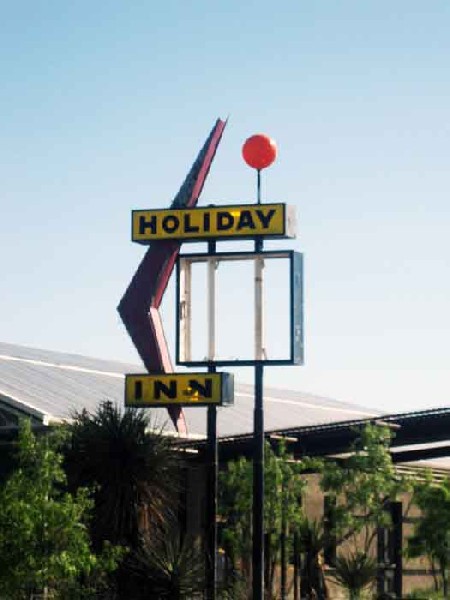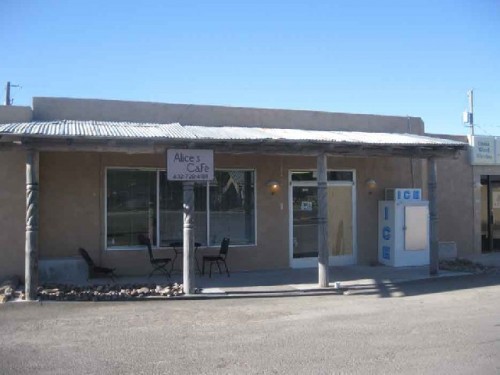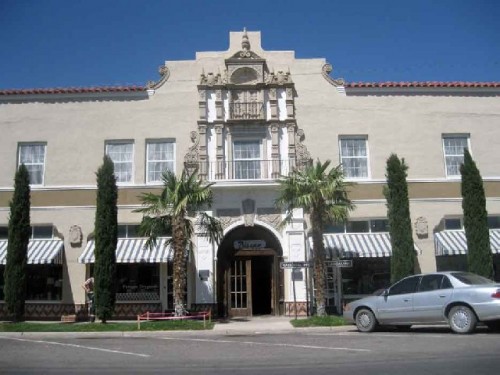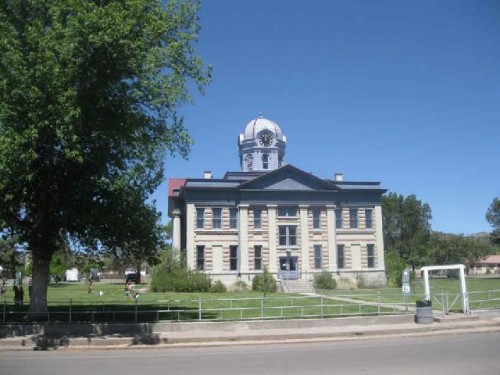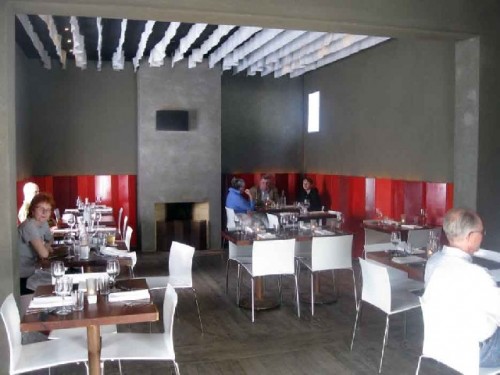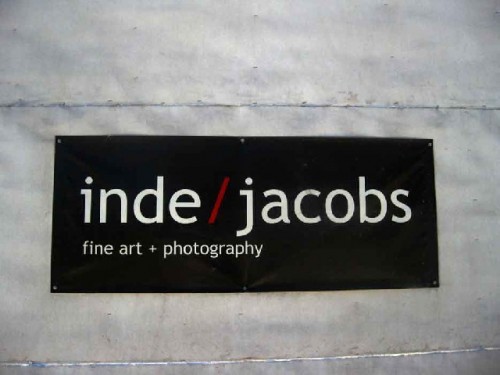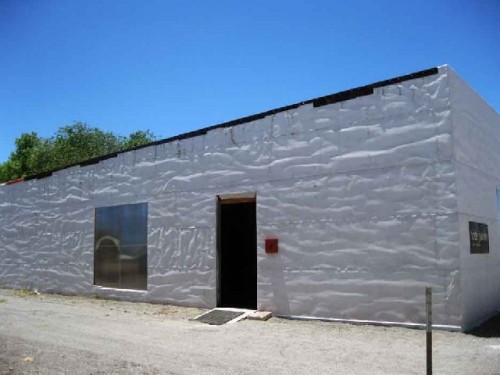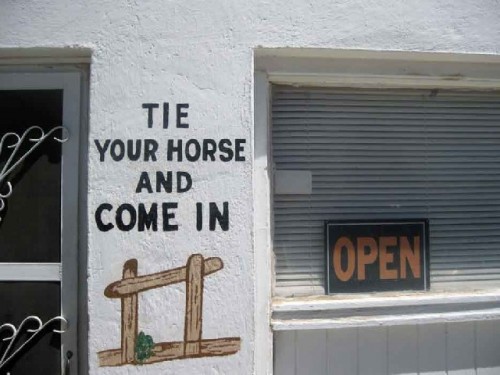Chinati and Donald Judd Foundations
Town and Gown in Marfa, Texas
By: Charles Giuliano - May 23, 2010
Visiting the Chinati and Donald Judd Foundations in Marfa, Texas evoked comparisons to other similar ventures to create vast contemporary museums in abandoned industrial spaces.
Some 20 years ago, Tom Krens, then director of the Williams College Museum of Art, talked with me about transforming the 17 acre former Sprague Electric campus in North Adams into the Massachusetts Museum of Contemporary Art. We spent the day touring enormous buildings in various states of disrepair.
I was reporting for Art News. An editor, Peggy Moorman, and I talked about buying cheap property in North Adams. The Holiday Inn could be had for about $250,000. That was pretty much the going price for sprawling factory buildings like the Beaver Mill and Eclipse Mill. A decent house was priced at under $100,000.
The idea that Krens conveyed to me at was using the enormous Sprague buildings for installations of minimal art. There were collectors who owned plans and drawings to fabricate works. Mostly they were created using cheap industrial materials which were durable. There would be no need for the expensive climate control that is standard with fine arts museums.
In essence Mass MoCA would be a warehouse for extended loans from major collectors. Also museums have work in storage that they are unable to show and are willing to loan. Most museums are capable of showing an increment of their collections.
It would take many years for Mass MoCA to become a reality. It has now celebrated its first decade of operation after another decade of development. While there are long term installations the museum has evolved as more complex than the original vision of Krens. But one aspect of that plan has been realized in the Sol LeWitt building where three floors of his wall drawings and paintings have been installed for the next 25 years. They are on extended loan from the artist’s estate and Yale University which owns the plans.
Eventually, we did buy property in North Adams in the 40 unit artist studio/ loft Eclipse Mill complex. It was developed by the artist Eric Rudd who bought it as well as the Beaver Mill. The Holiday Inn has also changed hands a couple of times and is now under renovation. A row of worker houses facing Mass MoCA have been developed into Porches an upscale inn.
We have visited Dia Beacon in New York which occupies a vast former printing plant for Nabisco. It is closer to the Krens concept of permanent installations of primarily works of minimal art.
Dia has undertaken a number of site specific projects with artists. Some of these are located in New York but also all over the United States including some remote locations. This has created the art equivalent of a pilgrimage route to seek out and view these installations.
One of the largest and most ambitious of these projects was developed with the artist Donald Judd on the site of a 340 acre former military facility in Marfa, Texas. There was a later disagreement between Judd, a brilliant conceptualist with a stubborn streak, and DIA. As the result of a split Judd created the Chinati Foundation named for the nearby mountains where he eventually owned ranches. He also bought large properties in town as living, storage and work spaces as well as ranches nearby.
When Judd (1928-1994) died there was a split in the estate and law suits. This resulted in the creation of the Chinati Foundation much as Judd had intended it as a public museum. It was primarily intended to have permanent displays of his own work as well as that of Dan Flavin (1933-1996) and John Chamberlain (Born 1927). There are installations by other artists Judd invited and worked with. While there are numerous other buildings that might be developed it is not clear whether the Chinati board is considering expansion.
The other half of the split was the creation of the Donald Judd Foundation which maintains his Marfa private spaces and ranches as well as an historic cast iron building he owned on Spring Street in lower Manhattan. Several years ago there was a deacession that brought $26 million at auction. It paid off debt but the foundation needs to raise funds to undertake the costly renovation of Spring Street.
One may visit the Chinati campus Wednesday through Sunday. There are tours at 10 AM and 2 PM. It is necessary to call or e mail for an appointment. The Judd Foundation is viewed by booking Wednesday through Saturday at 4:30 pm. There is also the important Bank building which may be viewed only on Fridays at 2 pm.
We dropped into the Judd Foundation office to book an appointment. Seeing the bank would have required staying another day. Showing my credentials as a member of AICA I asked if there might be an exception?
Craig V. Rember, the Mafa Locations Manager for the Judd Foundation, explained why that was not possible. Pointing to an associate he stated “You’re looking at the entire Marfa staff. The Foundation is run out of New York and they make all of the decisions.”
Talking with locals you get the drift that there is bad blood between the Chinati and Judd Foundations. I asked Rember if it is true that the left hand does not talk to the right hand.
“That is absolutely not true” he said. “We talk to and work with each other all the time.”
Visiting Marfa and touring the installations has been a long term ambition. Mostly I wanted to know how the exhibitions and programming compare to those in North Adams and Beacon. More than viewing the magnificent art there are issues about the human impact. Just how had Chinati and Judd transformed a depressed region of South West Texas.
The 340 acre Fort D.A. Russel was a thriving military base. During World War Two it incarcerated some 200 plus German prisoners of War. When the base closed the local economy tanked. Much as that happened in Beacon, when Nabicso closed, and in North Adams when Sprague left town.
Judd first visited Marfa, TX, in 1971, and moved from New York to Marfa as a full-time resident in 1977. Construction and installation at the site began in 1979 with initial assistance from the Dia Art Foundation in New York. The Chinati Foundation opened to the public in 1986 as an independent, non-profit, privately funded institution.
In addition to work by Judd, Flavin and Chamberlain the collection was expanded to include works by Carl Andre, Ingólfur Arnarsson, Roni Horn, Ilya Kabakov, Richard Long, Claes Oldenburg and Coosje van Bruggen, David Rabinowitch, and John Wesley. Mostly the work is installed in a separate building with some on the museum's grounds. Temporary exhibitions feature modern and contemporary art of diverse media. Currently Chinati has a temporary show of Judd’s horizontal relief sculptures.
The mantra is that artists move in, buy up abandoned and cheap real estate. Through sweat equity they put in resources that transform communities. They pay taxes which improve services and schools. There is increased equity. Eventually Starbucks moves in. Lofts and properties are flipped for double and triple the initial investment and artists move on or are forced out. Consider all the high rise condo development under way in Chelsea.
Emerging artists live double, triple and more in Brooklyn or have moved to New Jersey. Chelsea and Soho former artist lofts are bought by doctors, lawyers, and brokers. Only rich artists remain.
We put our ear to the ground in Marfa and heard the same kind of stories that are common in North Adams, Beacon, or wherever museums and artists have developed depressed properties.
Sitting around the pool at the Thunderbird Motel we chatted with two couples who had taken their kids swimming. We assumed they were passing through.
With a laugh they replied “No we live here.” Why I asked? For a lot of reasons was the response. Many people agree it is a wonderful area to live in and raise families. “We’re from California” the young girl said. They are among many young people and artists who have been attracted to live near Chinati. Just as artists cluster around Dia and Mass MoCA. Mostly they come for the magnificent landscape, mild winters, scorching summers, tasty Tex Mex food, and laid back lifestyle.
There is an airport in Marfa. This is convenient for upscale home owners and weekenders. Private plane are much more common in this region than in the North East.
As always in these rural areas with depressed economies jobs and income are issues. Our pool friends work independently and can live where they choose.
That night we dined in the upscale Cochineal Restaurant which had been recommended by our pool buddies. It was quite wonderful but pricey. Dinner for two with a dessert, no wine or appetizers, with tax and tip came to $75. The average bottle on the extensive wine list costs as much as our dinner for two.
That seemed like a lot for Marfa. The charming co owner who has relocated from Connecticut asked if we had enjoyed our meal? It seems they have been in business for two years and are surviving through local support, tourism, and overall development.
Arriving at Chinati for our morning tour a young woman greeted us. “Remember me” she asked. Megan had been the hostess the night before. It is her money gig. With some twenty other staff members she lives on the Chinati campus. She is a conservation intern preparing to apply to graduate school. The intern Logan who took us on tour was training two interns. They come for a three month residency. The guide who led three of us through the Judd Foundation is an artist who has been living in Marfa for three years. She holds a variety of part time jobs. And is planning her first trip to New York.
The morning tour at the Chinati Foundation which started at 10 ended at noon and resumed at 2 PM. That provided a long break for lunch. We also opted to visit a couple of art galleries. The Inde/ Jacobs Gallery, 208 East San Antonio appeared to be under renovation. The exterior of the box like structure was covered with paper insulation.
Entering we found a generic gallery space in transition with an exhibition of contemporary minimalism. The gallery also exhibits photography.
The gallerist was surprised when we introduced ourselves as visiting critics. “Critics never come in here” he said. Or the visiting collectors who buy work “with Matthew Marks in New York.. They don’t bother to come and look. They are missing out on something. We are representing the next generation of international minimalism.”
We learned that the design and renovation by their Swedish architect had gone over budget, and then some. It was just one of the struggles. Perhaps the most daunting one was that “Chinati basically was opposed to having galleries in Marfa. They were against any commercialization.”
So, all too typically, we learned that there little effort on the part of Chianti or the Donald Judd Foundation to enhance the efforts of the local business community. As is the case with Mass MoCA visitors come and go with no attempt to extend or enhance their visit to the host community. Under new mayor, Dick Alcombright, that is changing as there is now an active committee and renewed relationship between the museum and North Adams. This is a new initiative which will take time to have an impact.
Because the Chinati and Judd Foundations are magnets for creativity and cultural tourism there have been other developments. The Lannan Foundation has established a writers-in-residency program, a Marfa theater group has formed, and a multi-functional art space called Ballroom Marfa has begun to show art films, host musical performances, and exhibit other art installations. Recently there was a film festival.
In the 2000 census, there were 2,121 people, 863 households, and 555 families residing in Marfa. There were 1,354.6 people per square mile (521.6/km²). There were 1,126 housing units at an average density of 719.1/sq mi (276.9/km²). The racial makeup of the city was 91.04% White, 0.28% African American, 0.38% Native American, 0.05% Asian, 7.50% from other races, and 0.75% from two or more races. Hispanic or Latino of any race were 6.87% of the population.
The median income for a household in the city was $24,712, and the median income for a family was $32,328. Males had a median income of $25,804 versus $18,382 for females. The per capita income for the city was $14,636. About 15.7% of families and 20.6% of the population were below the poverty line.
While Marfa is evolving as an artists’ colony and vacation destination there are daunting development issues regarding the prevailing laid back lifestyle, limited labor pool, and reluctance to organize and promote the business community.
We asked the director of Inde/ Jacobs if the galleries of which there may be ten, depending on how you define the term, might develop mutual promotion and marketing? How about a gallery guide? DIA Beacon provides gallery information to visitors and organizes a monthly event coordinated with openings. The response was surprising. “Only a couple of us keep regularly posted hours.” So a gallery guide is impossible. He also expressed the difficulty of finding and training staff.
The carrot of opening galleries next to major contemporary museums like Mass MoCA, Chinati, and Dia is the potential of sophisticated upscale visitors. As anyone in the business will confirm it is not the number but rather the quality of traffic that counts. The challenge is how to create synergy with the museums. In that sense the Marfa initiatives are particularly problematic. They represent the singular vision of a now deceased artist who is often described as having been eccentric and even contentious. We are allowed to come and view the works or tour his private spaces. But there is no apparent mandate to enhance or encourage that traffic.
This contrasts with Mass MoCA which was established through $35 million in seed money from the Commonwealth of Massachusetts. It was pitched as bringing economic growth through cultural tourism to a depressed region. There is accordingly some mandate for accountability although, until recently, the museum has mostly been absorbed in its own struggle to survive. It is just beginning to focus on developing an endowment. Even though Mass MoCA has a poor track record regarding community relations, outreach, and development there is no such mandate or level of accountability for the private Chinati and Judd foundations.
One way to take the pulse of a community is to seek out the local eateries. For our second night we dined at Jett’s Grill in the traditional Hotel Paisano. It was used to house the actors and staff during the making of the classic Giant. The food was good and more affordable than the gourmet Cochineal. But the service was slow and the waiter inept. When confronted about an unitemized bill his defense was that “I’m just a college student.” OK then charge accordingly. This was all too indicative of sloppy management. But contrast the wait staff and food at Cochineal were superb. For top prices one expects excellent service. Even in Marfa.
One of the most popular dining options is Food Shark. It’s a truck that serves lively fresh food that customers enjoy at nearby benches under a shed. Looked great but we sought another option in the a hangout Carmen’s Café. This offered a true cross section of local customers, friendly service, down home food, and great gossip.
For breakfast we had tried the one woman Alice’s. Between cooking orders she sits and chats with her mostly middle aged Hispanic friends. It was a very homey place.
But during our second lunch visit to Carmen’s we engaged in an insightful dialogue with the hostess. She pulled no punches in stating that not only did Chinati have no real positive impact on her way of life it was even negative.
When asked about Arizona’s controversial immigration laws she has no problem with showing an ID if asked. “I’m a fifth generation American. The problem will be if the police are too aggressive and there will be law suits.”
While artists and vacationers have moved into Marfa that has driven up property values and taxes. “Local people can’t afford to live here. Outsiders come and think nothing about spending $250.000 for a home. Often they tear it down and rebuild. But they don’t hire local architects and contractors. The first thing they do is put up an adobe wall around their property.” (Which Judd did around his downtown living and studio compound.)
“In Marfa we pray a lot” she said. “We pray for Marfa. The artists don’t come to our church. They say that they have come here to educate us. But we don’t want to be educated. We like our traditional lifestyle. They are rich people who look down on us.”
But aren’t the artists, vacationers and tourists putting money into the local economy? “Some” she said. Do they come to your restaurant? “Yes, we are very successful” Looking around there was a party of a dozen that had assembled in Marfa for a wedding. We chatted with folks from Boston and Rhode Island. They were all in the arts.
“There was a film festival here recently” she said. “They say that eventually it will be bigger than Cannes. Everyone was excited about the potential business. But they set up tents and brought in caterers. There was no impact for local restaurants. We were very disappointed.”
A couple of Hispanic dudes walked in and were warmly greeted. One was tall and strikingly handsome with movie star looks. She told me he had been valedictorian of his class.
Ambling over I introduced myself and engaged in a conversation. It seems that Junior lives in Vegas and has a band. He has been in a couple of films. What are you doing here I asked?
“It’s my home man” he said. “I have a house here. I love Marfa and come back to be with my buddies and eat this great food.”
Exactly.
There will be a second report on Donald Judd, his work and vision for the Chinati Foundation

